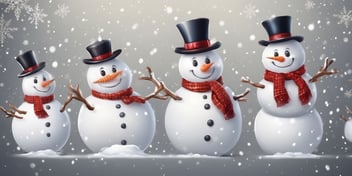- Blog
- Merry Christmas
- The Myth and Legend of Santa Claus in the Merry Christmas Tradition

As the air turns crisp and the scent of cinnamon fills the bustling city streets, there's no denying that the holiday season is upon us. Amidst the beautifully adorned trees, cheerful carols, and the flurry of gift shopping, one iconic figure effortlessly steals the spotlight year after year: Santa Claus. This jolly old man with his rosy cheeks and white beard has become an inseparable part of the Merry Christmas tradition, filling children's hearts with joy and wonder.
But have you ever wondered about the origins behind this beloved character? Join us as we delve into the mythology and legends surrounding Santa Claus, shedding light on the festive magic that has captivated both young and old for centuries.
Origin of Santa Claus
Evolution from Saint Nicholas
The legend of Santa Claus has evolved from the historical figure of Saint Nicholas, a Christian saint known for his charitable acts. Here are some key points highlighting the evolution:
- Saint Nicholas was originally portrayed as a solemn and religious figure, in contrast to the jolly and festive image of Santa Claus popularized today.
- The transformation began in the 19th century, influenced by various cultural and literary sources.
- Stories and poems, such as Clement Clarke Moore's "A Visit from St. Nicholas," helped to shape the modern persona of Santa Claus.
- The inclusion of a Merry Christmas Sleigh and reindeer, as seen in the 1823 poem, added a magical and whimsical element to the character.
- Over time, Santa Claus became the central figure in Christmas celebrations, embodying the spirit of gift-giving and joy.
By tracing the evolution of Santa Claus from Saint Nicholas, we can appreciate how this beloved figure has become an integral part of the Merry Christmas tradition.
Influence of European Folklore
The influence of European folklore is evident in the concept of Santa Claus and his Merry Christmas Sleigh.
- European legends such as the Dutch Sinterklaas and the British Father Christmas contributed to the development of Santa Claus.
- Sinterklaas, with his white beard and red attire, influenced the visual depiction of Santa.
- The idea of gift-giving during the holiday season, associated with Father Christmas, became a core element of Santa Claus tradition.
- European folklore also introduced the concept of Santa's sled or sleigh, pulled by magical reindeer, enabling him to deliver gifts worldwide.
- These folklore influences added depth and richness to the mythical figure of Santa Claus, making him an integral part of the Merry Christmas tradition.
The Merry Christmas Tradition
Santa Claus in Popular Culture
Santa Claus has become a ubiquitous figure in popular culture, especially during the Merry Christmas season. He is frequently featured in movies, television shows, advertisements, and even songs. This widespread representation of Santa Claus contributes to the overall festive atmosphere and reinforces the idea of gift-giving during the holidays. From classic movies depicting Santa's magical journey on his Merry Christmas Sleigh to modern commercials showcasing his jovial personality, popular culture has embraced Santa Claus as a beloved symbol of Christmas. These portrayals not only entertain audiences but also serve as a reminder of the joy and generosity associated with the holiday season.
The Iconic Santa Claus Image
The iconic Santa Claus image, with his red suit, white beard, and round belly, has become synonymous with the Merry Christmas tradition. This visual representation of Santa Claus sparks joy and excitement in people of all ages during the holiday season. From advertisements to decorations, the Santa Claus image is widely used to create a festive atmosphere and evoke warm feelings of nostalgia.
Whether seen on storefront displays or children's books, the Merry Christmas Sleigh and Santa Claus image immediately conveys the spirit of giving and magic that comes with the holiday season. It serves as a visual reminder of the joy and goodwill associated with Christmas.
The Role of Santa Claus in Christmas Celebrations
The presence of Santa Claus in Christmas celebrations adds joy and excitement, creating a magical atmosphere for both children and adults. Santa's arrival in his Merry Christmas Sleigh is often a highlight of holiday events, captivating audiences of all ages. Children eagerly anticipate his visit, hoping to receive gifts and experience the joy of believing in Santa's generosity.
Parents and caregivers use Santa's image and tradition as a way to reinforce good behavior and instill the spirit of giving during the festive season. Whether it's through letters to Santa or visits to Santa's grotto, the role of Santa Claus in Christmas celebrations brings smiles and creates lasting memories.
The Legend of Santa Claus
The Jolly Old Saint
- The Jolly Old Saint is the endearing persona of Santa Claus, known for his joyful and friendly demeanor.
- Santa's portrayal as a jolly character adds to the enchantment and joy of the Merry Christmas tradition.
- His laughter and rosy cheeks create a warm and welcoming atmosphere during the holiday season.
- The Jolly Old Saint represents the spirit of giving, spreading happiness, and embodying the magic of Christmas.
- Children and adults alike are captivated by his jolliness, making Santa Claus a beloved icon in the Merry Christmas tradition.
- The embodiment of the Jolly Old Saint brings smiles to faces and fills hearts with holiday cheer.
Depiction and Characteristics
- Santa Claus is often depicted as a jolly, rosy-cheeked old man with a long white beard, wearing a red suit trimmed with white fur.
- His warm and friendly demeanor, along with his hearty laughter, contributes to his portrayal as a beloved figure during the Christmas season.
- Santa's traditional depiction includes a merry Christmas sleigh filled with toys and gifts, pulled by a team of magical reindeer.
- The iconic image of Santa Claus on his sleigh flying through the night sky has become synonymous with the holiday season.
- This depiction and characterization of Santa Claus have been widely adopted in various forms of media and contribute to the festive atmosphere during Christmas.
The Santa Claus Myth
The Santa Claus myth has become a cornerstone of the Merry Christmas tradition. Portrayed as a jolly old man with a white beard, he embodies the spirit of gift-giving and joy during the holiday season. Children eagerly wait for him to visit their homes on his Merry Christmas Sleigh, delivering presents and spreading happiness. This mythical figure has captured the imagination of people worldwide, transcending cultural barriers.
The Santa Claus myth serves as a reminder of the magic and wonder associated with Christmas, keeping the spirit of generosity and love alive. It has become deeply ingrained in our festive celebrations, creating cherished memories for both young and old alike.
The Workshop and the Elves
The Workshop and the Elves, an integral part of the Merry Christmas tradition, bring Santa's magical toy production to life. The whimsical setting of the workshop and the tireless efforts of the cheerful elves epitomize the spirit of Christmas. With their nimble fingers and expert craftsmanship, the elves ensure that every child's wish is fulfilled. Their meticulous attention to detail and dedication to spreading joy make them invaluable helpers to Santa Claus.
Together, they work harmoniously to create the toys that will be loaded onto the Merry Christmas Sleigh, ready to be delivered to eager children around the world on Christmas Eve.
Santa's Magical Toy Production
Santa's magical toy production is a fascinating aspect of the Merry Christmas tradition. With his skilled workforce of enchanted elves, Santa creates a wide array of toys to deliver on Christmas Eve. This efficient production process allows Santa to fulfill the gift wishes of millions of children around the world. The workshop hums with activity as the elves utilize their magical abilities to craft toys with precision and speed.
Each toy is meticulously designed and crafted to bring joy and happiness to children on Christmas morning. Santa's ability to manufacture toys at such a large scale showcases his legendary abilities and adds to the enchantment of the holiday season.
Enchanted Elves Assisting Santa
Enchanted elves play a vital role in assisting Santa during his Merry Christmas Sleigh journey. These magical beings help with the production and distribution of toys, ensuring that every child receives a gift. With their nimble fingers and expert craftsmanship, the elves work tirelessly in Santa's workshop. They also aid in wrapping presents and loading the sleigh with precision and care.
Their dedication and attention to detail contribute to the seamless operation of Santa's gift-giving mission. Without the help of these enchanted helpers, Santa would face immense challenges in delivering joy to children worldwide.
The Merry Christmas Sleigh
The Merry Christmas Sleigh holds a special place in the legend of Santa Claus. It is the magical mode of transportation that allows Santa to deliver gifts around the world in a single night. The sleigh is often depicted as a red, ornate vehicle led by reindeer with the ability to fly. This iconic image has become synonymous with the holiday season and is widely recognized across cultures.
The Merry Christmas Sleigh adds an element of wonder and excitement to the Santa Claus myth, captivating both children and adults alike. It symbolizes the joy and magic of Christmas, creating a sense of anticipation and delight during the holiday season.
Santa's Magical Mode of Transportation
The Merry Christmas Sleigh is Santa Claus' magical mode of transportation, captivating both children and adults with its enchanting qualities. Here's a glimpse of its significance:
- The sleigh embodies the timeless tradition of gift-giving, connecting Santa to the joy and wonder of Christmas.
- Its ability to travel across the world in a single night showcases the magic and generosity associated with Santa Claus.
- The sleigh represents unity and togetherness, as Santa and his reindeer work harmoniously to deliver presents to homes worldwide.
- This iconic imagery sparks excitement and anticipation, adding to the festive atmosphere during the holiday season.
- The Merry Christmas Sleigh symbolizes the power of imagination, reminding us to embrace the childlike joy and wonder of Christmas.
The Reindeer and Flying Ability
- Reindeer have been an integral part of the Santa Claus legend, pulling his Merry Christmas Sleigh through the night sky.
- The concept of reindeer flying has captivated the imagination of both children and adults, adding enchantment to the Christmas tradition.
- By giving reindeer the ability to fly, Santa Claus is able to deliver gifts to children all over the world in a single night.
- While the idea of flying reindeer is purely fictional, it symbolizes the magic and wonder of the holiday season.
- The reindeer's fantastical flying ability reinforces the belief that anything is possible during this magical time of year.
The Impact of Santa Claus
Economic Impact of Christmas
The economic impact of Christmas is considerable, with businesses across various sectors benefiting from increased consumer spending during the holiday season. Retailers, both online and brick-and-mortar, witness a surge in sales as people shop for gifts, decorations, and festive essentials. The demand for seasonal goods creates job opportunities in manufacturing, distribution, and retail sectors.
The Role of Santa in Boosting Seasonal Sales
The role of Santa in boosting seasonal sales cannot be ignored. His iconic image and association with gift-giving create a sense of excitement and urgency among consumers. Retailers capitalize on this by using Santa Claus in their marketing campaigns, advertisements, and store displays. The Merry Christmas Sleigh bells heard around malls and shopping centers further enhance the festive atmosphere and attract shoppers.
Additionally, Santa-themed promotions and discounts increase foot traffic and encourage impulse buying.
Santa Claus as a Marketing Tool
In the world of marketing, Santa Claus has become an effective tool to drive consumer engagement during the Merry Christmas season. His jolly image and association with gift-giving resonate with people of all ages, making him a valuable asset for businesses. Companies use Santa Claus in various promotional campaigns, incorporating his image into advertisements, social media posts, and even in-store displays.
By leveraging the popularity and appeal of Santa Claus, brands can create a festive atmosphere and evoke emotions of joy and goodwill, thereby encouraging customer participation and increasing sales. This marketing approach allows companies to tap into the holiday spirit and connect with customers on a personal level, fostering brand loyalty and memorable experiences.
Cultural Significance of Santa Claus
Santa Claus holds a significant cultural role during the Merry Christmas tradition. As a symbol of generosity and goodwill, Santa Claus embodies the spirit of the holiday season. He represents the universal idea of giving, fostering a sense of warmth and joy in communities worldwide. By embracing the image of Santa Claus, individuals are encouraged to adopt acts of kindness and generosity, aligning with the core values of Christmas. This cultural significance is visible in various ways, such as charitable initiatives and community events that promote unity and compassion. Santa Claus serves as a reminder of the importance of spreading love and happiness during the festive season.
Santa Claus as a Symbol of Generosity
- Santa Claus embodies the spirit of generosity and giving during the Merry Christmas season.
- He serves as a shining example of selflessness, inspiring people to be generous and kind towards others.
- Through his act of delivering gifts to children around the world, Santa Claus encourages people to think beyond themselves and spread joy and happiness.
- Santa's generosity extends beyond material gifts; it also encompasses acts of compassion and charity.
- People often participate in charitable events during the holiday season, taking inspiration from Santa's generosity.
- Santa Claus symbolizes the importance of giving without expecting anything in return, fostering a sense of community and love.
- His image reminds us to be generous not only during the holidays but throughout the year, making a positive impact on those around us.
The Influence of Santa Claus in Creating Holiday Spirit
The presence of Santa Claus during the holiday season has a profound impact on creating a joyful and festive atmosphere. His jolly demeanor, red suit, and iconic Merry Christmas sleigh evoke feelings of anticipation and excitement. Children and adults alike are drawn to the merriment and magic associated with Santa Claus, which helps foster a sense of togetherness and happiness during Christmas.
Whether it's through Santa's presence at malls, community events, or personalized letters and gifts,his influence ignites the holiday spirit and brings people closer, spreading joy and cheer throughout the season.
Wrapping up
Santa Claus is a beloved figure in the Christmas tradition, but his origins and legends have often been shrouded in mystery. The myth of Santa Claus has evolved over time, drawing from various sources and folklore. The character we know today as Santa Claus has its roots in the stories of Saint Nicholas, a generous Christian bishop who lived in the 4th century. Over the centuries, different cultures around the world have added their own unique elements and customs to the Santa Claus myth.
The modern image of Santa Claus as a jolly, rotund man in a red suit was popularized by Coca-Cola advertisements in the early 20th century. Despite the commercialization of the character, Santa Claus remains a symbol of generosity, love, and the magic of Christmas for people of all ages.
Read On

Santa Claus: The Ultimate Guide to the Jolly Old Man in Red
Ah, the holiday season is upon us with all its glittering lights, joyful carols, and the sweet...

Rediscovering the Cheerful Origins of 'Jolly Old Saint Nicholas'
'Twas the night before Christmas, and all through the land, cheerful anticipation danced hand in...

Who is Santa Claus, and where did the legend come from?
Every holiday season, children around the world eagerly await the arrival of a jolly, bearded...